SCIENCE REPORTER SUMMARY: MAY 2024
ARTICLE 1:
- ARTICLE 1:
- ARTICLE 2:
- ARTICLE 3:
- ARTICLE 4:
- ARTICLE 5:
- ARTICLE 6:
- ARTICLE 7:
- ARTICLE 8:
- ARTICLE 9:
- ARTICLE 10:
- ARTICLE 11:
- ARTICLE 12:
- ARTICLE 13:
- NEWS IN BRIEF
- 2) Solar cell you can bend and soak in water
- 3) Window coating blocks heat without blocking a clear view
- 4) Researchers develop cost-effective motion sensors for healthcare applications
Researchers Develop Sensor to Track Disease Progression: & Provide Rapid Medical Support
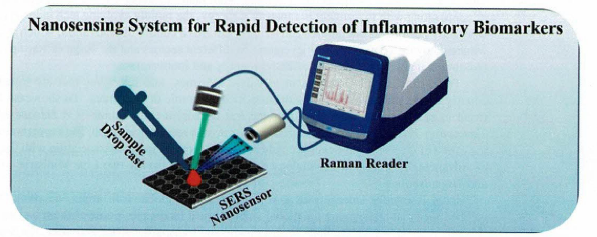
Quick Detection of Cytokines with Nanosensor:
- Researchers at the Indian Institute of Technology (IIT) Jodhpur have developed an innovative nanosensor that facilitates the rapid detection of cytokines, proteins crucial for cell regulation.
- This advancement aims to lower mortality rates associated with delayed diagnoses and insufficient early warning systems.
- The technology shows promise as a rapid, point-of-care technique for health monitoring, disease diagnosis, prognosis, and tracking immune responses.
Importance of Cytokines in Medicine:
- Cytokines serve as biomarkers for inflammation, essential for diagnosing diseases and monitoring their progression.
- They play a significant role in tissue damage repair, cancer progression, and immune response modulation, making them vital for precision medicine and targeted therapies in oncology, infectiology, and rheumatology.
Promising Results and Future Scope:
- Published in the 2023 IEEE Applied Sensing Conference (APSCON), the work highlights the technique’s effectiveness for detecting three key pro-inflammatory cytokines: interleukin-6 (IL-6), interleukin-8 (IL-8), and TNF-alpha.
- Currently tested on controlled samples, the team, led by Prof. Ajay Agarwal from the Department of Electrical Engineering, aims to progress to clinical trials and expand the technology’s application to early-stage diagnoses of sepsis and fungal infections.
Surface-Enhanced Raman Spectroscopy for Precision Detection:
- The novel sensor utilizes Surface-Enhanced Raman Spectroscopy (SERS) to detect low concentrations of analytes with high precision and selectivity.
- This sensor, based on semiconductor process technology, leverages the SERS principle to identify trace-level molecules accurately, making it a powerful diagnostic tool.
Advantages Over Traditional Methods:
- Traditional cytokine detection techniques like Enzyme-Linked Immunosorbent Assay (ELISA) and Polymerase Chain Reaction (PCR) are reliable but time-consuming, requiring skilled personnel and extensive sample preparation, often taking over six hours.
- In contrast, the IIT Jodhpur-developed sensor delivers results in just 30 minutes, offering a cost-effective alternative.
Integration with AI for Enhanced Diagnosis
- This rapid and selective diagnostic sensor, when combined with AI, enhances the speed and accuracy of data processing and analysis.
- This integration enables quicker, more robust diagnoses of autoimmune diseases and bacterial infections, potentially transforming patient medical treatment by allowing timely diagnosis and tracking to guide future treatment strategies.
ARTICLE 2:
Novel Hydrogel Removes Microplastics from Water

Threat of Microplastics to Human Health and the Environment:
- Microplastics, tiny plastic debris, pose significant risks to human health and the environment.
- These particles can enter human bodies through drinking water, increasing illness risks.
- Additionally, they are a widespread environmental hazard, found even in remote areas like polar ice caps and deep ocean trenches, where they threaten both aquatic and terrestrial life.
IISc’s Sustainable Hydrogel Solution:
- In response to this emerging pollutant, researchers at the Indian Institute of Science (IISc), Bengaluru, have created a sustainable hydrogel designed to remove microplastics from water.
- This innovative material features an intertwined polymer network capable of binding and degrading contaminants using UV light irradiation.
Limitations of Traditional Methods:
- Traditional methods, such as filtering membranes, often become clogged with microplastics, making them unsustainable.
- The IISc team, led by Professor Suryasarathi Bose from the Department of Materials Engineering, turned to 3D hydrogels as an alternative solution.
Innovative Hydrogel Design:
- The novel hydrogel developed by the IISc team comprises three different polymer layers—chitosan, polyvinyl alcohol, and polyaniline—intertwined to form an Interpenetrating Polymer Network (IPN).
- This matrix is infused with nanoclusters of Copper Substitute Polyoxometalate (Cu-POM), which act as catalysts to degrade microplastics under UV light.
- The combination of these polymers and nanoclusters results in a robust hydrogel capable of adsorbing and degrading significant amounts of microplastics.
Laboratory Simulation and Efficacy:

- To simulate real-world conditions, the team created microplastics in the lab by crushing common household plastics.
- They tracked the hydrogel’s effectiveness by adding a fluorescent dye to the microplastics, allowing them to monitor adsorption and degradation under various conditions.
- The hydrogel demonstrated high efficiency, removing about 95% of polyvinyl chloride and 93% of polypropylene microplastics from water at near-neutral pH (~6.5).
Durability and Sustainability:
- The hydrogel proved durable and stable under various temperatures, maintaining efficacy over five cycles of microplastic removal.
- Additionally, the hydrogel can be repurposed into carbon nanomaterials for removing heavy metals from polluted water once it has outlived its primary use, enhancing its sustainability.
Future Applications:
- Looking ahead, the IISc researchers plan to collaborate on developing a scalable device to deploy this hydrogel technology widely, aiming to clean up microplastics from various water sources on a larger scale.
ARTICLE 3:
IIM Lucknow Study Reveals Agtech Platforms’ Role in Digitising Indian Agriculture
Digitisation of India’s Agricultural Sector
- The Indian Institute of Management Lucknow’s research highlights the transformative potential of digitising India’s farming and agricultural sectors.
- This transformation is driven by Agtech platforms, which enhance digital literacy among farmers, provide data-driven insights, and bridge the digital gap in agriculture.
- The study examines four major Agtech platforms in India—Dehaat, Samunnati Agrielevate, IFFCO Bazar, and KRIBHCO-CSC-eGov—demonstrating how these platforms leverage network effects to revolutionize the industry.
Major Agtech Platforms and Network Effects:
- Focusing on the four largest Agtech platforms in India, the study involves expert consultations and data analysis to explore their impact on network effects.
- These platforms enhance their value proposition through various functions such as matching, transactional activities, discovery, and evaluation.
- Experts emphasizes the importance of these platforms in developing digital agribusiness strategies, particularly in the context of emerging digital markets like the Open Network for Digital Commerce (ONDC).
Components and Partners of Agtech Platforms:
- The analysis identifies essential components for Agtech platforms in emerging markets.
- These include partnerships with third-party financial institutions to provide microcredit and facilitate transactions, and collaborations with warehouse and logistic partners to enhance efficiency.
- Social media modules are also crucial, enabling peer-to-peer feedback and information sharing, which promotes transparency and increases platform value through direct user interaction.
Governance Models: Cooperative vs. Private:
- The study contrasts the governance models of cooperative and privately held Agtech platforms.
- IFFCO Bazar and KRIBHCO CSC-eGov exemplify platform cooperatives with shared ownership and democratic governance, empowering farmers through collective decision-making and community-driven initiatives.
- In contrast, Dehaat and Agrielevate, as privately held companies, prioritize profit and adopt firm-led control and ownership governance.
- While both models have their pros and cons, the cooperative approach is noted for its inclusive, community-centered governance that aligns platform objectives with agricultural stakeholders’ interests.
Practical Implications for Agribusiness:
- Experts highlights the study’s contribution to understanding the Agtech platform domain, offering a practical framework for agribusiness managers.
- This framework helps identify relevant partner organizations and anticipate their impact on network effects and overall value proposition.
- A successful Agtech platform is defined by a clear value proposition, and partnering firms that align with this tend to be more successful.
- The study also suggests strategies for expanding agricultural platforms by enhancing positive network effects.
Future Research Directions:
- The findings provide valuable insights for researchers, offering a starting point for further exploration of issues such as low farmer acceptance rates of these platforms.
- By examining agricultural platform configurations and design aspects from stakeholders’ viewpoints, the research offers a deeper understanding of Agtech platform dynamics, paving the way for future studies and advancements in the field.
ARTICLE 4:
Making Safer Painkillers
The Risks of Painkillers: Ibuprofen

- Painkillers, often the first response to discomfort, carry potential risks despite their seemingly simple nature.
- Ibuprofen, a common Nonsteroidal Anti-inflammatory Drug (NSAID) marketed under various brands, promises relief but also poses several health risks that need careful consideration.
Gastrointestinal and Cardiovascular Concerns
- Ibuprofen can cause gastrointestinal discomfort, including acidity, vomiting, and in severe cases, gastrointestinal bleeding.
- This is particularly concerning for individuals with a history of ulcers or digestive issues.
- Additionally, Ibuprofen has been linked to cardiovascular complications, such as an increased risk of heart attacks and strokes.
- Prolonged or excessive use can also lead to kidney and liver damage and worsen asthma, necessitating consumption under medical supervision.
Understanding Chemical Compounds
- The chemical composition and structure of compounds like Ibuprofen are crucial for comprehending their effects and risks.
- Chemical compounds, including Ibuprofen, have complex molecular structures.
- Isomers, which have the same chemical formula but different properties due to the arrangement of atoms, play a significant role in the behavior of these compounds.
The Role of Enantiomers in Ibuprofen
- Ibuprofen is a racemic mixture containing two enantiomers: S-Ibuprofen and R-Ibuprofen.
- S-Ibuprofen is pharmacologically active and significantly more potent than R-Ibuprofen.
- The presence of both enantiomers in Ibuprofen contributes to its side effects and potential toxicity.
- Ideally, isolating S-Ibuprofen would enhance the drug’s safety and efficacy, but this process is complex and expensive.
Advances in Chiral Separation
- Recent advancements by scientists at CSIR-NEIST (CSIR-North East Institute of Science and Technology), Jorhat, have led to the development of a novel membrane coated with Graphene Oxide (GO) for chiral separation.
- This membrane has shown exceptional performance, achieving over 96.53% separation of S-Ibuprofen from R-Ibuprofen. It is reusable for multiple cycles, maintaining stability and improving chiral isomer separation.
Implications of the New Membrane Technology
- CSIR-NEIST’s innovative membrane technology is a significant breakthrough.
- It can make Ibuprofen safer and more effective, allowing for lower doses and reduced side effects.
- This advancement not only enhances the drug’s efficacy but also sets a benchmark for future developments in chiral separation technologies, potentially transforming the pharmaceutical industry.
ARTICLE 5:
How Artificial Intelligence is Transforming Education
Human Intelligence vs. Artificial Intelligence
Human Intelligence:
- Human intelligence is characterized by the capacity to understand, learn, reason, and deal with new or challenging situations.
- It involves the brain’s cognitive abilities, memory, and processing of sensory input.
- This natural intelligence is unique to humans and allows for complex problem-solving, emotional understanding, and abstract thinking.
Artificial Intelligence (AI):
- AI refers to the intelligence demonstrated by machines, where they simulate human cognitive functions such as learning and problem-solving.
- Unlike human intelligence, AI relies on data provided by humans. This machine-based intelligence can process information faster, adapt to changes more efficiently, and maintain a high level of accuracy and objectivity.
- AI’s capabilities are rooted in computational models and algorithms that process large volumes of data to make decisions.

Development and Impact of AI
History and Significance:
- AI, a branch of computer science, was coined by John McCarthy in 1956. It is considered one of the most crucial technologies of the 21st century, poised to drive significant changes across various sectors.
- Examples of AI in everyday life include Google Maps, search engines, spam filters, language translation services, and intelligent personal assistants like Siri and Alexa.
AI Subfields: Machine Learning and Deep Learning:
- Machine learning, a subset of AI, involves training computers to perform tasks without explicit programming.
- Deep learning, a further subset of machine learning, utilizes artificial neural networks that mimic the human brain’s function to process data and create patterns for decision-making.

Functioning of AI Systems
Design and Operation:
- AI systems are designed to simulate human cognitive abilities like perception, reasoning, and problem-solving.
- These systems are programmed to create a knowledge base comprising facts, assumptions, and rules for decision-making.
- They rely on large datasets from various sources and employ algorithms to process and analyze this data, extracting patterns to make predictions or decisions.
Neural Networks and Learning Management Systems:
- Artificial neural networks, integral to deep learning, mimic the human brain’s function to transmit messages and perform complex tasks.
- AI-based Learning Management Systems (LMS) enhance educational content management and delivery, providing personalized learning experiences and intelligent support systems for students.
AI in Education
Transforming Education:
- AI has the potential to revolutionize education by enabling personalized learning, where educational content and teaching methods are tailored to individual student needs.
- This shift from the traditional “one size fits all” approach addresses diverse learning styles and capacities.

Innovative Educational Tools:
- AI facilitates the creation of personalized curriculums, virtual tutors, smart content, and AI-powered assessments.
- These tools help streamline grading, provide consistent feedback, and ensure academic integrity through AI-based proctoring systems.
Enhanced Learning Experiences:
- AI-powered virtual classrooms, interactive simulations, and virtual laboratories offer immersive and engaging learning experiences.
- These innovations help students understand complex scientific concepts and collaborate more effectively.
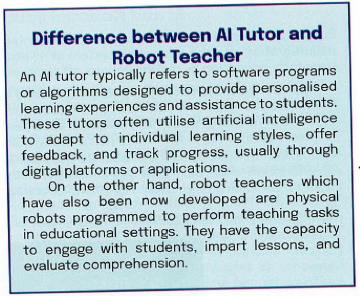
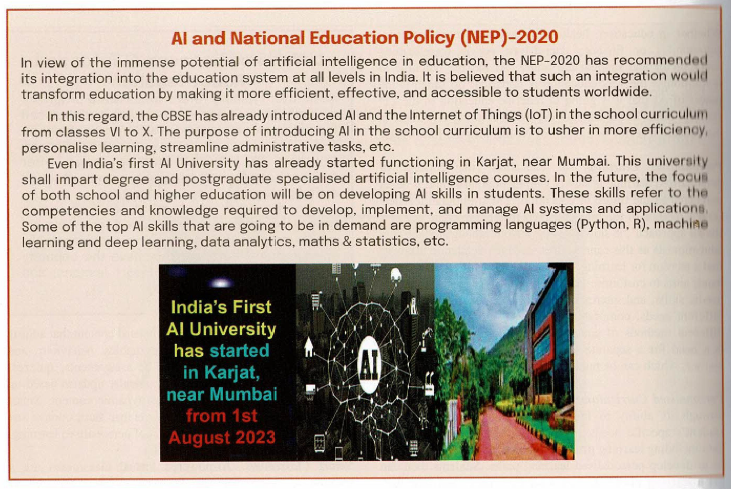
AI in Research
Accelerating Research:
- AI significantly enhances research across various disciplines by quickly analyzing large datasets, discovering patterns, and providing insights.
- It is employed in fields like biology, astronomy, and medicine, aiding in complex visual data interpretation and accelerating processes like drug discovery.
Environmental and Ethical Considerations:
- Despite its benefits, AI poses challenges such as privacy concerns, environmental costs, and potential job displacement due to automation.
- Addressing these issues is crucial to harness AI’s full potential while mitigating its adverse effects.
Transition in Education
From Traditional to AI-Integrated Learning:
- Education is transitioning from traditional methods to online and AI-integrated learning.
- Online education offers flexibility and accessibility, but AI provides the personalization and engagement necessary for effective learning experiences.
- This shift aims to cater to diverse learning needs and improve educational outcomes.
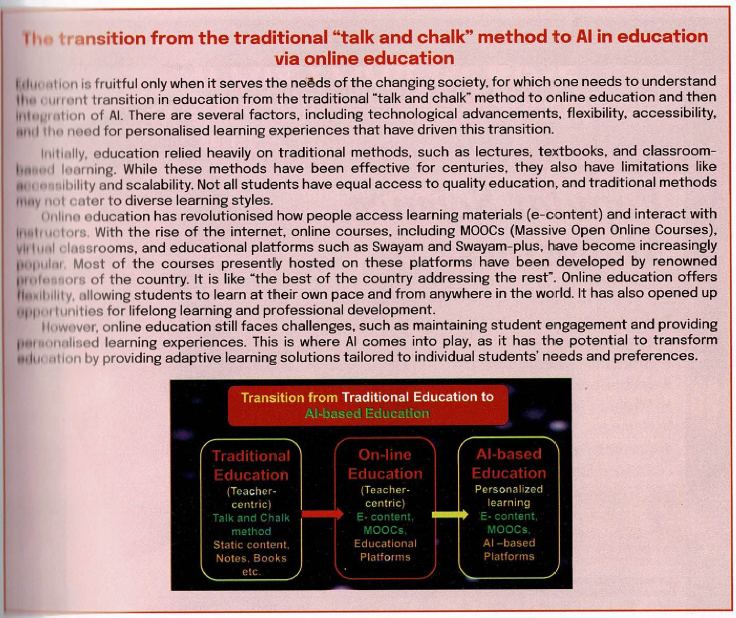
Balancing Innovation and Ethics:
- As AI continues to transform education, it is essential to address ethical, environmental, and privacy concerns to ensure that technological advancements contribute positively to society and education remains a pathway to opportunity and progress.
ARTICLE 6:
Al ON YOUR DEVICE: Why 2024 will be a watershed year for PCs and smartphones
Introduction to AI in Personal Technology
- The integration of Artificial Intelligence (AI) into the hardware and software of personal technology devices has emerged as a major breakthrough in early 2024.
- Over the past few years, AI has made significant inroads into the lives of both lay users and professionals, revolutionizing the way we interact with technology.
- This wave of innovation was spurred by the advent of “Chat GPT,” developed by the then-unknown company OpenAI in 2022, which popularized generative AI capable of learning from existing data and creating new text and images.
- This breakthrough allowed millions to delegate various tasks, such as writing reports and completing homework, to AI-powered tools like Bing AI or Copilot.
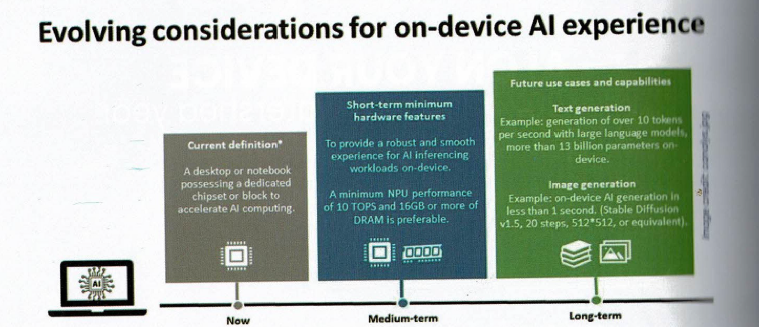
Onboard AI Capabilities in Personal Devices
- Traditionally, AI capabilities were cloud-based, requiring an internet connection to access these tools. The game-changer in early 2024 has been the introduction of onboard AI capabilities in personal devices, enabling real-time responses without relying on cloud-based tools.
- This innovation, which started with personal computers and smartphones, ensures that AI can function swiftly and securely on the device itself, providing a seamless user experience.

AI-Capable Personal Computers
Definition and Market Adoption
- An AI-capable PC, as defined by technology analysts Canalys, requires dedicated chipsets or blocks to run AI workloads on-device. In the short term, AI PCs are defined by their ability to handle 10 trillion operations per second (TOPS) using 16 GB or more RAM.
- These PCs are expected to manage over 13 billion parameters and generate AI images in under one second. Canalys predicts that almost one in five PCs shipped in 2024 will be AI-capable, with this number growing to over 60% by 2027.
Industry Response
- Major PC manufacturers have already launched new AI-capable models incorporating Neural Processing Units (NPUs) into their hardware.
- These advancements, combined with the shift to Microsoft’s Windows 11, promise significant benefits for users who require AI for enhanced privacy, security, and efficiency in their work.
Dedicated AI Key and New Utilities
- The introduction of dedicated AI keys on PC keyboards represents a significant innovation, providing quick access to AI tools such as Copilot in Windows 11 PCs.
- This development, previewed at the CES in Las Vegas in January 2024, has led to the launch of AI-enhanced PCs like the Gigabyte gaming laptop and the ASUS ZenBook 14 OLED.
- These models offer utilities powered by AI, such as extended battery life, improved gaming performance, and quick-start generative-AI apps.
AI in Smartphones
The AI Phone Revolution
- January 2024 marked the debut of the world’s first AI phone, the Samsung Galaxy S24, which integrates AI capabilities directly into the phone’s hardware.
- Manufactured in India, this phone features generative AI tools for communication, transcription, and interactive search, all powered by Qualcomm’s Snapdragon Gen 3 chip.
- This innovation promises to transform mobile phone usage by providing AI capabilities without the need for internet-based tools.
Advanced AI Features
- The AI capabilities in smartphones extend to virtual assistants that can summarize phone calls, provide recommendations, and enhance photo editing.
- These features, though not all immediately available, highlight the potential of AI to revolutionize mobile phone functionalities.
- Analysts predict that over one billion smartphones with built-in generative AI will be shipped by 2027, signaling a major shift in personal technology.
The Future of AI-Driven Personal Technology
- AI-driven devices like PCs, laptops, and smartphones, though novelties today, are expected to become commonplace within the next 5 to 10 years.
- As AI capabilities continue to integrate seamlessly into personal technology, users will likely look back on pre-2024 devices as primitive, highlighting the rapid advancement and transformative power of AI in everyday technology.
ARTICLE 7:
ARTIFICIAL WOMB: A revolutionary reproductive technology or next-gen humans
The Role of Science and Technology in Daily Life
- Science and technological innovations have become integral to everyday life, significantly impacting sectors like agriculture, healthcare, and communication.
- Biotechnology and advanced machinery have revolutionized medical treatments, enabling complex procedures like organ replacement through stem cell techniques and 3D printing.
- In reproductive healthcare, practices such as IVF, surrogacy, and gene editing are becoming routine, though the human component remains essential in these processes.
Emergence of Artificial Wombs
- The concept of artificial wombs, once relegated to science fiction, is now moving towards reality due to advancements in biotechnology and reproductive science.
- An artificial womb, or ectogenesis chamber, simulates the uterine environment, supporting embryo or fetus development outside the human body.
- This technology aims to aid extremely premature infants, enhancing their chances of survival and healthy development.
Historical Background and Early Research
- The idea of artificial wombs was first proposed by British scientist J.B.S. Haldane in 1924, who coined the term “ectogenesis.” Haldane envisioned gestation outside the human body, potentially altering societal power dynamics by separating reproduction from the biological constraints of pregnancy.

- Subsequent thinkers, like Emanuel M. Greenberg in the 1950s, explored the concept, although the technological limitations of the time prevented practical implementation.

Mid-20th Century Advances
- During the mid-20th century, scientific study of artificial wombs gained traction with breakthroughs in in vitro fertilization and embryo culture. British scientist Christopher Polge’s successful incubation of rabbit embryos in 1955 set the stage for further advancements.
- Researchers like Robert G. Edwards and Patrick Steptoe contributed significantly to IVF techniques, while advancements in tissue engineering and biomaterials further refined artificial womb technology.
Recent Developments and Innovations
- Interest in artificial wombs surged in 2017 when researchers at the Children’s Hospital of Philadelphia developed the “Biobag,” successfully nurturing premature lambs outside their mothers’ wombs.
- This system uses a fluid environment mimicking amniotic fluid and an oxygenating device connected to the umbilical cord.
- While this technology has shown promise in animal models, it faces significant regulatory and ethical challenges before human application.
Ethical and Societal Implications
- The development of artificial wombs prompts numerous ethical and societal considerations. The potential to grow fetuses outside the human body could redefine parenthood, raising questions about the legal and moral status of children born through this technology.
- Concerns about genetic stratification and eugenics also arise, highlighting the need for robust ethical frameworks to ensure equality and respect for human dignity.
Future Prospects and Challenges
- As artificial womb technology advances, it may revolutionize reproduction, offering solutions for infertility and premature births, and enabling same-sex couples or single individuals to have biological children.
- However, this progress necessitates careful consideration of the ethical, legal, and societal impacts.
- Questions about the upbringing and mental health of children born through artificial means, as well as the potential societal divides between naturally and artificially born individuals, must be addressed by regulatory bodies before widespread adoption.
Conclusion
- The advent of artificial wombs represents a significant scientific and technological milestone with profound implications for society.
- While promising enhanced survival rates for premature infants and new reproductive possibilities, this technology also demands careful ethical scrutiny and regulatory oversight to navigate the complex challenges it presents.
ARTICLE 8:
The Great North American Eclipse 2024
Excitement Surrounding the Total Solar Eclipse of April 2024
- The anticipation for the total solar eclipse on April 8, 2024, in North America has been unparalleled. Years before the event, astronomers, educators, students, local communities, and eclipse enthusiasts began preparing for this celestial spectacle.
- The solar corona, the Sun’s outer atmosphere, visible only during totality, is a significant point of interest.
- The awe-inspiring sight of a total eclipse leaves a lasting impression on viewers, with stories and experiences shared widely.

Understanding the Solar Corona
- The solar corona is a rarefied layer of hot ionized gases extending a few solar radii from the Sun’s surface. It has an extremely low density, much thinner than Earth’s atmosphere at sea level.
- The corona’s plasma, heated to millions of degrees by magnetic energy, is not yet fully understood.
- Observing the corona during a total eclipse provides a unique opportunity to study these high-energy processes.

Frequency and Path of Total Solar Eclipses
- Approximately 238 solar eclipses occur in a century, with a total eclipse happening every 18 months somewhere on Earth. However, a total eclipse repeats at any given location only once every 350-400 years.
- The maximum duration of totality is 7 minutes and 31 seconds, with the path of totality being about 250 km wide.
- For the April 2024 eclipse, the path of totality, 162-200 km wide, will traverse Mexico, the United States from Texas to Maine, and Canada, hence dubbed the “Great North-American Eclipse.”

Optimal Viewing Locations and Weather Predictions
- The April 2024 eclipse will offer optimal viewing in specific locations. In Mexico, cities like Mazatlan, Durango, Torreón, and Piedras Negras are prime spots.
- In the US, Arkansas, Texas, and Oklahoma are favorable due to better weather conditions.
- However, there are concerns about the El Niño effect, which could influence weather patterns. The eclipse’s totality will last between three to over four minutes, depending on the location along the central line.
Preparations for the Eclipse
- Anticipating large crowds, local administrations, and communities have issued guidelines and prepared resources.
- The Federal Highway Administration created solar eclipse interstate road maps and “do-not-stop” lists for truckers. Communities were advised to stock up on essentials and encourage carpooling.
- School authorities in many states declared a day off to avoid traffic issues, and several regions issued disaster declarations to manage the influx of visitors.
Scientific and Public Engagement
- The scientific community planned various sophisticated experiments, including NASA’s citizen science program using WB-57 High-altitude Research Planes and Solar Patrol.
- NASA also initiated the Eclipse Megamovie 2024 (EM2024) project, inviting citizen scientists to capture and analyze images of the eclipse. Public outreach included lectures, astronomy films, and live-streaming of the event, engaging a wide audience in this celestial phenomenon.

Torreón: A Prime Viewing Location
- Torreón, in the state of Coahuila, Mexico, was chosen by many for its favorable weather patterns and low average cloud cover.
- The city, known for its semi-desert climate, museums, monuments, and industries, prepared extensively for the influx of visitors.
- The city’s iconic landmark, El Cristo de las Noas, added a cultural touch to the scientific event, making Torreón a significant spot for eclipse observers.
The total solar eclipse of April 2024 promises to be a historic event, blending scientific discovery with public enthusiasm, and bringing communities together to witness one of nature’s most extraordinary displays.
ARTICLE 9:
MATH: A Centre of Excellence dedicated to AI and ML
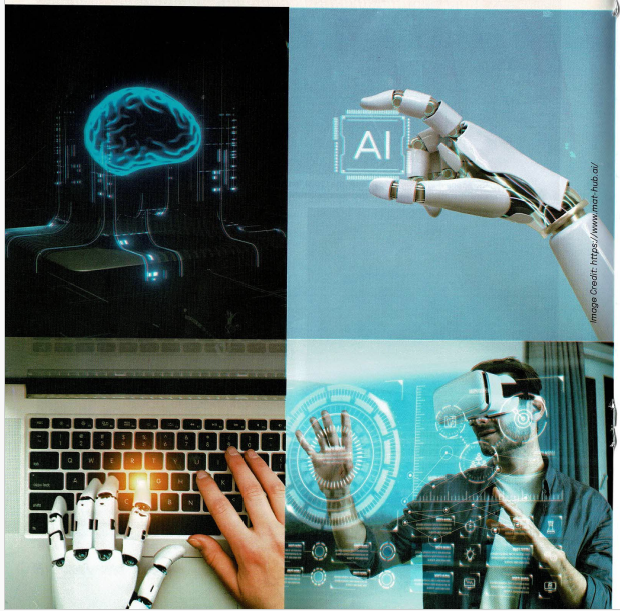
Introduction to MATH: A New Hub for AI Innovation
- The Department of Science and Technology (DST), in collaboration with T-Hub, a Hyderabad-based start-up incubator, has inaugurated the Centre of Excellence — Machine Learning and Artificial Intelligence Technology Hub (MATH).
- This initiative aims to foster AI innovation and support start-ups in India. Combining government support, technological infrastructure, and entrepreneurial spirit, MATH seeks to position India as a global leader in AI.
Objectives and Facilities of MATH
- MATH aims to create 500 AI-related jobs by the end of 2025 and support over 150 start-ups annually. The centre features a mini data centre with GPU capabilities, an advanced Learning Management System (LMS) tailored for AI education, and robust data infrastructure.
- By offering a conducive environment for experimentation and collaboration, MATH aspires to drive breakthrough innovations in AI, addressing societal challenges and creating new economic opportunities. One of its key goals is to bridge the gap between academia and industry, fostering knowledge exchange and collaborative research.
Enabling Ecosystem for AI Start-ups
- India’s rise as a global AI leader depends on creating an ecosystem that nurtures creativity, collaboration, and risk-taking among start-ups. The DST formulates policies, allocates funds, and provides strategic direction to promote scientific research and technological innovation across sectors.
- T-Hub, India’s largest start-up ecosystem builder, facilitates innovation by providing start-ups with access to mentors, investors, corporate partnerships, and global networks.
- The collaboration between DST and T-Hub leverages their strengths to create a thriving ecosystem for AI-driven start-ups.
Capacity-Building Programmes at MATH
- The DST-T-Hub Centre of Excellence offers various capacity-building programmes to equip start-ups with essential skills and resources.
- These programmes cover business strategy, product development, marketing, fundraising, and intellectual property rights, helping start-ups navigate the competitive AI landscape.
Specialized Offerings at MATH
- Math Lab: A cutting-edge AI/ML lab that empowers start-ups to develop innovative solutions.
- Math Nuage: A virtual incubation platform providing extensive support and resources for AI/ML entrepreneurs.
- Math Co-Working: Dynamic offices and incubation spaces spread over 50,000 square feet, offering a conducive environment for start-ups.
- Nurturing AI Minds (NAIM): An advanced LMS for comprehensive AI/ML learning.
- MAD Lake: A centralized data repository that accommodates all data forms, enabling start-ups to leverage their data assets fully.
- AI Career Finder: A platform connecting start-ups with top AI/ML professionals and candidates seeking exciting opportunities.
Future Prospects
- The collaboration between DST and T-Hub to boost AI innovation and nurture AI-driven start-ups is a significant step towards realizing India’s potential as a global AI leader.
- By leveraging collective resources, expertise, and networks, MATH aims to create a vibrant ecosystem where start-ups can innovate, collaborate, and scale their impact.
- This initiative promises to drive economic growth, social progress, and technological advancement in India.
ARTICLE 10:
Way to Heal: STEM CELLS & REGENERATIVE MEDICINE

Human Healing Capabilities
- Human bodies have a remarkable capacity to heal from physical damage, such as small cuts and wounds. However, there are limits to this regenerative ability.
- Unlike some reptiles, such as salamanders, which can regenerate almost any body part, humans cannot regrow entire limbs. The liver is the only organ in humans known to fully regenerate.
- The key to this difference lies in special cells known as stem cells, which have the potential to develop into various cell types.
Understanding Stem Cells
- Stem cells, first termed “Stammzelle” by German biologist Ernst Haeckel in the 1800s, are unique cells capable of differentiating into various specialized cell types like muscle, cardiac, and neurons. Originally thought to only be germ cells, recent studies have revealed that even somatic cells can exhibit stem cell properties.
- Stem cells are classified based on their potency: totipotent (capable of forming all cell types including the placenta), pluripotent (able to form all cell types except the placenta), and multipotent (able to form a limited range of cell types).
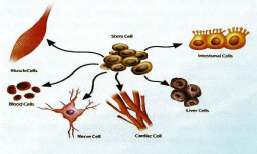
Recent Advances in Stem Cell Research
- A major breakthrough in stem cell research was the discovery of induced pluripotent stem cells (iPSCs) by Japanese scientist Shinya Yamanaka, who won the Nobel Prize in Physiology in 2012. iPSCs are adult cells reprogrammed to behave like embryonic stem cells (ESCs).
- While iPSCs hold great potential, they are still less efficient and more tumorigenic than ESCs. Both types of stem cells are being explored for their therapeutic potential to replace lost tissues and organs.

Therapeutic Potential and Challenges
- Stem cells offer promising avenues for regenerative medicine, potentially replacing damaged tissues and organs. However, challenges remain, such as the risk of immune rejection, tumor formation, and ethical concerns regarding ESC use.
- Immunosuppressants have been used to mitigate immune rejection, but they are not foolproof. iPSCs present fewer ethical issues and less risk of immune rejection but still pose tumor risks and have low efficiency.
Future of Regenerative Medicine
- Regenerative medicine is evolving from organ transplants to cell-based therapies and now to the realm of biomaterials and implants.
- Biomaterials, both natural and synthetic, interact with biological systems to support tissue architecture and function.
- Advances in 3D printing and nanotechnology are enhancing the development of biocompatible and porous biomaterials. Implants, such as pacemakers and cochlear implants, are being developed to replace or support damaged biological structures.
Looking Ahead
- The future of regenerative medicine holds the promise of advanced therapies combining stem cells and biomaterials to address various medical conditions.
- With ongoing research and technological advancements, we may soon see the development of implants and treatments capable of restoring lost limbs and organs.
- However, significant questions remain regarding the body’s acceptance of these changes and the costs associated with maintaining these advanced therapies.
ARTICLE 11:
SYMMETRY: AN INTRICATE CONGEPT

The Concept of Symmetry in Nature and Design
- Symmetry generally signifies harmony, balance, beauty, and unity. Observations of nature, such as flowers and butterflies, reveal inherent symmetrical patterns.
- Similarly, symmetry is prevalent in human-made structures and art. It is easy to recognize visual or geometrical symmetry, which can be classified into bilateral, reflection, and radial symmetry.
- Bilateral symmetry is evident when an object is mirrored along a central axis, reflection symmetry occurs with mirror images, and radial symmetry involves rotation around a central point, as seen in circular designs and the human body.
Scientific Definitions of Symmetry
- Physicists and mathematicians define symmetry more precisely. For them, symmetry means that certain operations leave an object unchanged. For instance, a rubber ball remains the same when rotated, demonstrating rotational symmetry.
- In physics, space and time exhibit symmetries known as “translational invariance” and “time translational invariance,” respectively.
- These symmetries imply that the laws of physics are consistent across different locations and moments in time.

Symmetry in Classical and Relativistic Physics
- In classical mechanics, symmetry exists between the state of rest and uniform motion, termed Galilean invariance. This principle explains why physical laws apply equally whether a car is moving at a steady speed or at rest.
- Einstein’s special theory of relativity introduced the concept of Lorentz invariance, where the speed of light remains constant regardless of the observer’s motion, leading to phenomena like length contraction and time dilation.
- These effects become significant at extremely high velocities.
Noether’s Theorem and Conservation Laws
- Einstein’s general theory of relativity, proposed in 1915, faced challenges regarding energy conservation in curved space-time.
- Emmy Noether’s theorem resolved these issues by linking symmetries with conservation laws. Her theorem demonstrated that the conservation of energy, momentum, and angular momentum is a direct consequence of the symmetries of space and time.
- This groundbreaking work established that symmetries inherently imply conservation laws and vice versa, forming a fundamental principle in modern physics.

Charge Symmetry and Isospin
- Beyond space and time symmetries, other related symmetries like charge symmetry exist. Charge symmetry refers to the nuclear force being identical between neutrons and protons.
- Charge independence extends this concept, stating that nuclear forces between any nucleons are the same.
- These ideas led to the concept of isospin, an abstract way of describing the symmetry between neutrons and protons. Isospin plays a crucial role in understanding nuclear physics.

Hidden and Broken Symmetries
- The study of hidden or broken symmetries has also advanced physics. The 2008 Nobel Prize in Physics was awarded for work on broken symmetries, which are crucial for understanding the universe’s evolution post-Big Bang.
- Symmetry breaking is thought to have led to the dominance of matter over antimatter in the universe. The Higgs mechanism, another consequence of symmetry breaking, explains how particles gained mass in the early universe.
- Despite these breakthroughs, some symmetry-based predictions, like supersymmetric particles, remain unobserved, suggesting areas for future research.

Supersymmetry and Future Discoveries
- Supersymmetry proposes that every particle has a supersymmetric counterpart, differing by half a spin unit.
- Although these “sparticles” have not been detected yet, their discovery could explain fundamental questions in physics, such as the nature of dark matter and the relative weakness of gravity.
- Future particle accelerators may provide the necessary conditions to detect these elusive particles, potentially revolutionizing our understanding of the universe.
ARTICLE 12:
Unveiling the Future of Al BINNS-Biologically Inspired Neural Networks
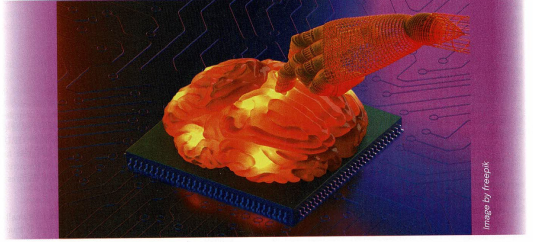
Introduction to Biologically Inspired Neural Networks (BINNs)
- Biologically Inspired Neural Networks (BINNs) are a subset of artificial neural networks that draw inspiration from biological systems.
- These networks aim to replicate the functioning of biological neurons and synapses, offering potential improvements in efficiency and adaptability over traditional Artificial Neural Networks (ANNs).
Spiking Neural Networks (SNNs)
Behavior and Processing:
- Spiking Neural Networks (SNNs) emulate the behavior of biological neurons, using spikes or action potentials to transmit information.
- Unlike ANNs, which process continuous input signals, SNNs use event-driven processing where neurons accumulate input signals over time and generate output spikes upon reaching a threshold.
- This mechanism makes SNNs particularly effective for tasks requiring precise timing, such as pattern recognition and synchronization.
Applications:
- Neuromorphic Hardware: SNNs are integral to the development of neuromorphic hardware, which mimics the brain’s structure and function for ultra-efficient, low-power processing in IoT devices, autonomous vehicles, and robotics.
- Sensory Processing: SNNs excel in handling sensory data processing tasks, including speech recognition, image and video analysis, and sensor fusion, leveraging the temporal aspect of spikes.
- Brain-Computer Interfaces (BCIs): SNNs facilitate efficient communication between humans and machines, enabling individuals with motor disabilities to control devices with their thoughts.
- Cognitive Computing Systems: SNNs show great promise in cognitive computing, aiming to replicate human-like decision-making processes.
- Biomedical Research: SNNs complement traditional AI techniques by analyzing complex biological data, providing deeper insights and pattern recognition.
Liquid State Machines (LSMs)
Components and Processes:
- Liquid State Machines (LSMs) are inspired by the fluid dynamics of liquids, which adapt and process information dynamically.
- An LSM consists of a computational reservoir of interconnected neurons that generate complex activity patterns in response to input data.
- The readout mechanism processes the reservoir’s state to produce an output.

Applications:
- Time-Series Prediction: LSMs are proficient at processing time-series data, making them useful for weather forecasting, financial market predictions, and anticipatory control in robots.
- Speech Recognition: LSMs adapt to various speakers and accents, improving the accuracy of speech recognition systems.
Echo State Networks (ESNs)
Concept and Structure:
- Echo State Networks (ESNs) use the concept of echoes metaphorically to process and remember information dynamically. An ESN comprises a reservoir of neurons with a fixed state of weights, acting as dynamic memory that retains information from previous inputs. This structure allows ESNs to excel in time-series forecasting, natural language processing, control systems, and cognitive modeling.
Gated Recurrent Units (GRUs) and Long Short-Term Memory (LSTM) Networks
Architecture and Functionality:
- GRUs and LSTMs are specialized Recurrent Neural Networks (RNNs) designed for sequential data analysis, addressing the challenges of capturing long-term dependencies and correlations.
- GRUs: Featuring a simplified architecture, GRUs employ a gating mechanism with reset and update gates to regulate information flow, efficiently handling long-range dependencies without maintaining separate cell states.
- LSTMs: Introduced earlier than GRUs, LSTMs have complex memory cells and three gates (input, output, and forget) to capture long-term dependencies, excelling in tasks like machine translation and speech recognition.
Applications:
- Natural Language Processing (NLP): GRUs and LSTMs are indispensable in NLP tasks such as sentiment analysis, language modeling, and machine translation.
- Speech Recognition: These networks improve accuracy and robustness in automatic speech recognition.
- Time-Series Forecasting: GRUs and LSTMs are valuable for time-series analysis and forecasting in finance, weather prediction, and demand planning.
- Healthcare: They are used in healthcare for patient monitoring, disease prediction, and drug discovery.
Convolutional Neural Networks (CNNs)
Structure and Function:
Convolutional Neural Networks (CNNs) are designed to handle visual data, such as images and videos. They consist of three main building blocks:
- Convolutional Layers: Detect shapes, edges, and textures by applying convolution operations to the input data.
- Pooling Layers: Reduce the dimensionality of data while retaining important features, aiding in abstraction.
- Fully Connected Layers: Classify detected features into specific categories.
Applications:
- Image Classification: CNNs excel at identifying objects, animals, and scenes in photographs.
- Object Detection: Useful for recognizing and locating objects within images or videos.
- Facial Recognition: Employed in security, authentication, and social media tagging.
- Medical Imaging: Analyze X-rays, MRI scans, and pathology slides to diagnose medical conditions.
Deep Belief Networks (DBNs)
- DBNs consist of multiple layers of neurons, typically composed of Restricted Boltzmann Machines (RBMs), capturing probabilistic relationships between variables.
- They undergo pre-training and fine-tuning phases to recognize patterns and features in data.
Applications of DBNs:
- Image and Speech Recognition
- Recommendation Systems
- Natural Language Processing
- Healthcare
- Anomaly Detection
- Neuroevolutionary Algorithms (NEAs)
NEAs combine neural networks and evolutionary algorithms, optimizing neural networks through processes mimicking natural selection. This iterative process improves network performance over generations.
Applications of NEAs:
- Robotics
- Game Playing
- Optimization
- Neurorehabilitation
- Natural Language Processing
Neurocognitive Networks
- Neurocognitive networks mimic human-like cognitive processes, integrating principles from cognitive psychology and neuroscience to process sensory input, perform cognitive processing, and adapt through learning.
Applications of Neurocognitive Networks:
- Natural Language Processing
- Image and Video Analysis
- Decision Support
- AI Assistants
- Human-Machine Interaction
Biophysics Inspired Neural Networks (BiophysINNs)
- BiophysINNs are inspired by the biophysics of biological systems, incorporating components such as neurons, ion channels, and synapses modeled after biological counterparts.
- The Hodgkin-Huxley model imparts biophysical accuracy to their computations.
Applications of BiophysINNs:
- Neural System Simulation
- Drug Discovery
- Robotic Systems
- Personalized Experience
BINNs represent a frontier in AI, combining biological insights with advanced computational techniques to create more efficient, adaptable, and human-like AI systems.
ARTICLE 13:
Chromatic Marvel: The Fascinating Life and Death of Labord’s Chameleon

Life Cycle and Adaptations:
- Labord’s chameleon (Furcifer labordi), inhabiting the dry and deciduous forests of western Madagascar, has a remarkable yet short life span.
- Spending nearly eight months inside the egg, this chameleon survives for only four to five months post-hatching, as it dies almost immediately after reproduction.
- This unique life cycle, characterized by semelparity, is believed to be an adaptation to Madagascar’s extreme climate and competition with other chameleon species.
Colorful Phenomenon:
- Despite its brief life, Labord’s chameleon captivates with its vibrant display of colors controlled by its nervous system.
- Specialized skin cells called chromatophores are responsible for this transformation.
- These cells contain various pigments such as xanthophores and erythrophores on the surface, and melanin deeper within.
- Triggered by temperature or mood changes, the nervous system activates these chromatophores, creating dazzling color displays across the chameleon’s body, even in its final moments.

Biological Insights:
- Researchers suggest that the chameleon’s short lifespan may also be influenced by oxidative stress affecting telomeres, according to findings published in Scientific Reports.
- Telomeres, protective caps at the end of chromosomes, play a crucial role in regulating lifespan.
- Understanding these molecular and cellular mechanisms sheds light on the chameleon’s adaptation strategies to survive in challenging environments.
Conservation and Fascination:
- Labord’s chameleon continues to fascinate researchers and nature enthusiasts alike, not only for its vibrant colors but also for its resilience in the face of environmental pressures.
- These creatures serve as a reminder of nature’s beauty and the diversity of life on Earth, emphasizing the importance of conservation efforts to protect these unique marvels.
Labord’s chameleon exemplifies nature’s adaptation to survive and thrive in challenging habitats, showcasing a brief yet spectacular existence that highlights the wonders of Madagascar’s biodiversity.
NEWS IN BRIEF
1) Indigenously-developed electric standing wheelchair

- Researchers at IIT Madras have innovated with NeoStand, an electric standing wheelchair designed to enhance user experience and functionality.
- This compact wheelchair features a motorized standing mechanism that allows users to effortlessly transition from sitting to standing at the touch of a button.
- NeoStand aims to empower wheelchair users by enabling eye-level interactions, accessing higher surfaces, and enjoying standing activities like reading or having a coffee.
- Its user-centric design prioritizes comfort and functionality, offering users the flexibility to sit for extended periods while mitigating the risk of secondary health issues associated with prolonged sitting.
2) Solar cell you can bend and soak in water

- Researchers from the RIKEN Center for Emergent Matter Science and their collaborators have developed a breakthrough organic photovoltaic film that combines waterproof properties with flexibility.
- This advancement allows solar cells to be integrated into clothing, remaining functional even after exposure to rain or washing.
- The innovation is crucial for creating wearable electronics that can be seamlessly attached to garments, such as medical monitoring devices, without compromising on flexibility or requiring frequent battery changes.
- The research, detailed in Nature Communications, addresses previous challenges of maintaining waterproofing in flexible films without sacrificing their flexibility.
3) Window coating blocks heat without blocking a clear view

- Researchers from the University of Notre Dame have developed a new window coating designed to selectively allow visible sunlight while blocking ultraviolet and infrared rays, which contribute to interior heating.
- This innovation aims to maintain cooler indoor temperatures and save energy by reducing the need for air conditioning. Utilizing quantum computing techniques, the researchers ensured the coating’s effectiveness throughout the day, regardless of the sun’s position.
- Importantly, the coating can be integrated into existing windows and vehicles without requiring replacements. Results of the study were published in Cell Reports Physical Science.
4) Researchers develop cost-effective motion sensors for healthcare applications

The Organohydrogel sensor is cost-effective and boasts a shelf life exceeding 50 days. The findings detailing its capabilities have been published in ACS Applied Material and Interfaces.
Researchers from IIT Guwahati have developed a low-cost, gel-based wearable device called Organohydrogel sensor capable of recording motion signals.
This innovative device can monitor subtle movements over an extended period when placed on patients in comatose states or similar conditions. It wirelessly transmits data to a smartphone, enabling continuous healthcare monitoring.



